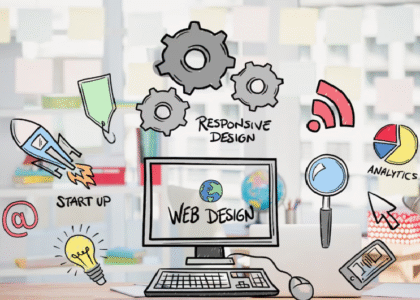The success of any digital product in today’s digital era is founded on user interface and user experience design. The psychological aspects of design can make a good design great; it makes the product useful not only for the users but also an enjoyment. This article aims to explore the psychological bases of good UI/UX design and how to enable it to make digital experiences engaging and user-friendly.

ADVERTISEMENT
The Power of First Impressions
First impressions matter in UI/UX design. As soon as users land on a new webpage or an app, literally in a matter of seconds, an impression is created about it. This initial impression is made up of several psychological factors:
-
- Visual Apeal: Humans are basically wired to get attracted to beautiful designs. A good user interface gives a positive impression, and users tend to stick with the product if it is visually appealing. The elements that affect visual appeal are color schemes, typography, imagery, and layout.
- Simplicity and clarity: it gives the user an easy and quick idea of what the website or an app is about. An intuitive interface reduces cognitive load, leaving the users worry-free when they perform the task at hand, due to it not making them overwhelmed. Better navigation and structured content will improve the user experience at once.
- Consistency: The designing elements such as buttons, icons, and fonts tell the user where they are and what they are doing. The user will feel more comfortable using the product if he is familiar with the patterns and knows what actions will call what response.
ADVERTISEMENT
The importance of cognitive load
The effortful mental activity exerted toward the cognition of the cognitive load, however, is also deemed necessary and hence the need to manage cognitive load in UI/UX lest users fail to reach their goals and get lost in confusion and frustration. Some major strategies to reduce the cognitive load are:
- Chunking Information: Today, Breaking information into smaller, chewable chunks helps make it clear and understandable to users. For example, grouping related menu items together or presenting information incrementally through the concept of progressive disclosure helps an interface feel much more intuitive and less complex.
- Visual hierarchy: There should be a very clear hierarchy placed on the visual plane, which directs users toward looking at the most important parts of the page. Size, color, and placement can be utilized with other elements to prioritize content and make it scannable.
- Subtracted Choice: Too many choices can overload the users and create decision fatigue. Limiting the number of choices and making them understandable and clear will lead the users to being able to make choices quickly and confidently.
Emotional Design
Emotions have a major role in the way a user feels about and interacts with a product. Emotional design emphasizes positive emotional responses to elevate the experience. Some key aspects of Emotional design include;
-
- Delightful interactions: Small and delightful interactions such as animations, micro-interactions, and feedback, make interactions joyful and create feelings of satisfaction. They personalize the product and make it memorable.
- Human-Centered Design: Designing with empathetic and informed by human needs, desired experiences, and pain points paves the way for a meaningful relationship between users and their experience. A human-centered mechanism should, therefore, encompass user research, personal development, and user journeying.
- Trust and Credibility: The establishment of trust is very vital. Transparent design, clear communications, equally important branding, and the retention of data security and privacy may develop the credibility and confidence of the end-users of the product.
ADVERTISEMENT
The Influence of Behavioral Psychology
Behavioral psychology reveals how users make their decisions and take action. Therefore, designers understand these principles and build interfaces by which users are lured to the end. The key concepts include:
-
- Affordances: Visual cues that make it clear what an interaction with an element does, like a clickable button or a draggable slider. Clear affordances guide users on how an interface operates without the need for instructions.
- Feedback and Rewards: Providing immediate feedback for user action upon which is reinforcing. For instance, when the form is successfully submitted, a check mark or form-processing animation is presented, during which the content loads in the background. Awards can be in the form of badges, points, or progress bars to entice users to complete tasks and maintain interest.
- Persuasion Techniques: Techniques such as social proof, scarcity, and reciprocity manipulate user behavior. For instance, user reviews, limited-time offers in their display, or providing incentives can guide users to make a purchase or subscribe to a newsletter.
ADVERTISEMENT
The Importance of Usability Testing
Usability testing can be conducted to test the operating system, which is part of the design process for the entire UI/UX. Observations from actual users interacting with the product in a natural setting help to pick out possible usability problems that may exist and to collect feedback. Usability testing brings out insights that are very possible with design solutions.
- Identify pain points: Usability testing helps to identify areas where users are having problems or become frustrated. From here, one can thus make targeted changes to effect an overall improvement in the usability of the product.
- Validate design decisions: Testing with real users will give valuable feedback in the design decisions to ensure that design matches user expectations and caters to needs associated.
- Iterative Improvement: Usability testing follows a process of iterations. The test does not end with the first result but continues for the improvement of the results as usual with feedback from users.
ADVERTISEMENT
Conclusion
Understanding of psychological factors in designing UI/UX is vital to creating successful digital products. By considering such factors as first impressions, cognitive load, emotional design, behavioral psychology and usability testing, it’s possible to craft not just functional interfaces but engaging ones. A user-centered approach, finally, focused on psychological needs and preferences, is poised to yield better engagement and more compelling value for digital experiences.
ADVERTISEMENT






